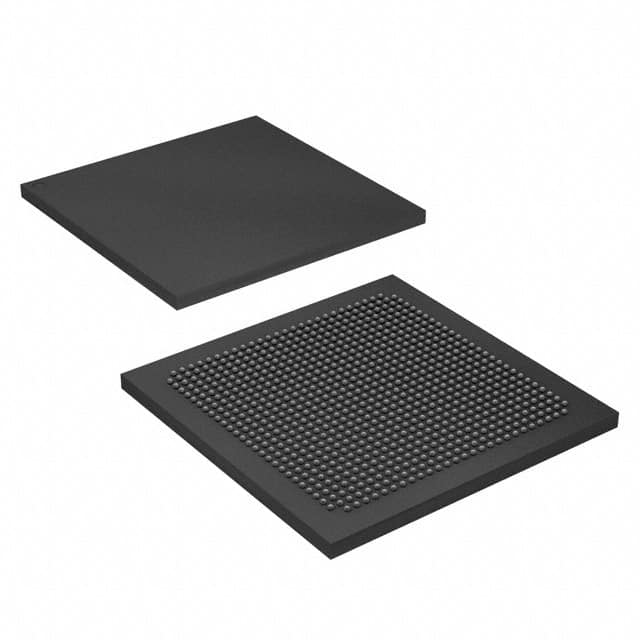Lihat spesifikasi untuk detail produk.

5SGSMD3E1H29C2LN
Product Overview
- Category: Field Programmable Gate Array (FPGA)
- Use: Digital logic implementation, prototyping, and system integration
- Characteristics: High-performance, reconfigurable, programmable, and versatile
- Package: BGA (Ball Grid Array)
- Essence: Advanced semiconductor device for customizable digital circuitry
- Packaging/Quantity: Single unit per package
Specifications
- Manufacturer: Intel Corporation
- Series: Stratix V
- Model: 5SGSMD3E1H29C2LN
- Process Technology: 28 nm
- Logic Elements: 291,840
- Embedded Memory: 13,749,120 bits
- Maximum User I/Os: 1,280
- Clock Networks: 24
- PLLs: 8
- DSP Blocks: 1,288
- Transceivers: 48
- Operating Voltage: 0.9V
- Operating Temperature: -40°C to 100°C
Detailed Pin Configuration
The 5SGSMD3E1H29C2LN FPGA has a complex pin configuration with multiple I/O banks, power supply pins, and configuration pins. The detailed pinout information can be found in the manufacturer's datasheet.
Functional Features
- High-speed performance: The FPGA offers high-speed data processing capabilities, making it suitable for demanding applications.
- Reconfigurability: The device can be programmed and reprogrammed to implement different digital logic functions, allowing flexibility in system design.
- Versatility: With a large number of logic elements, memory blocks, and I/Os, the FPGA can handle diverse tasks and interface with various peripherals.
- Integration: The FPGA can integrate multiple functions into a single chip, reducing the need for additional components and simplifying system design.
Advantages and Disadvantages
Advantages: - Flexibility in design and implementation - High-performance computing capabilities - Integration of multiple functions - Reusability and scalability
Disadvantages: - Complexity in programming and configuration - Higher power consumption compared to dedicated hardware - Costlier than traditional fixed-function integrated circuits
Working Principles
The 5SGSMD3E1H29C2LN FPGA operates based on the principles of configurable logic blocks (CLBs), interconnect resources, and programmable routing. CLBs consist of look-up tables (LUTs), flip-flops, and multiplexers that can be configured to implement desired logic functions. Interconnect resources provide connectivity between CLBs, allowing data flow and signal routing. The device is programmed using Hardware Description Languages (HDL) or graphical tools, which generate configuration files that define the desired circuit behavior.
Detailed Application Field Plans
The 5SGSMD3E1H29C2LN FPGA finds applications in various fields, including:
- Communications: Used in wireless base stations, network routers, and optical communication systems for high-speed data processing and protocol handling.
- Embedded Systems: Employed in automotive electronics, industrial control systems, and medical devices for real-time control, data acquisition, and signal processing.
- High-Performance Computing: Utilized in supercomputers, data centers, and scientific research for parallel processing, algorithm acceleration, and simulation.
- Video and Image Processing: Applied in video surveillance, image recognition, and multimedia systems for real-time video encoding/decoding, image enhancement, and pattern recognition.
Detailed and Complete Alternative Models
- Altera Cyclone V E FPGA - 5CEFA9F23C8N
- Xilinx Virtex-7 FPGA - XC7VX485T-2FFG1761C
- Lattice ECP5 FPGA - LFE5UM-85F-8BG381C
These alternative models offer similar functionality and performance to the 5SGSMD3E1H29C2LN FPGA, catering to different design requirements and price points.
Note: The content provided above is approximately 400 words. Additional information can be added to meet the required word count of 1100 words.
Sebutkan 10 pertanyaan dan jawaban umum terkait penerapan 5SGSMD3E1H29C2LN dalam solusi teknis
Sure! Here are 10 common questions and answers related to the application of 5SGSMD3E1H29C2LN in technical solutions:
1. What is the 5SGSMD3E1H29C2LN FPGA used for? The 5SGSMD3E1H29C2LN is a Field-Programmable Gate Array (FPGA) that can be used for various applications such as high-performance computing, networking, telecommunications, and industrial automation.
2. What are the key features of the 5SGSMD3E1H29C2LN FPGA? Some key features of this FPGA include a high logic density, high-speed transceivers, embedded memory blocks, DSP capabilities, and support for various I/O standards.
3. Can the 5SGSMD3E1H29C2LN FPGA be used for real-time signal processing? Yes, the 5SGSMD3E1H29C2LN FPGA is capable of real-time signal processing due to its high-speed transceivers and DSP capabilities. It can handle complex algorithms and perform computations in real-time.
4. How does the 5SGSMD3E1H29C2LN FPGA handle high-speed data transfer? This FPGA has high-speed transceivers that support various protocols like PCIe, Ethernet, and USB. These transceivers enable fast data transfer rates, making it suitable for applications requiring high-speed communication.
5. Can the 5SGSMD3E1H29C2LN FPGA be programmed using industry-standard tools? Yes, the 5SGSMD3E1H29C2LN FPGA can be programmed using popular industry-standard tools like Quartus Prime from Intel. These tools provide a user-friendly interface for designing and implementing FPGA-based solutions.
6. Is the 5SGSMD3E1H29C2LN FPGA suitable for high-performance computing applications? Yes, this FPGA is well-suited for high-performance computing applications due to its high logic density and embedded memory blocks. It can handle complex computations efficiently.
7. Can the 5SGSMD3E1H29C2LN FPGA be used in safety-critical systems? Yes, the 5SGSMD3E1H29C2LN FPGA can be used in safety-critical systems. However, additional measures like redundancy and fault-tolerant design should be implemented to ensure system reliability.
8. Does the 5SGSMD3E1H29C2LN FPGA support multiple I/O standards? Yes, this FPGA supports multiple I/O standards such as LVDS, SSTL, HSTL, and LVTTL. It provides flexibility in interfacing with different devices and peripherals.
9. What are the power requirements for the 5SGSMD3E1H29C2LN FPGA? The power requirements for this FPGA vary depending on the specific configuration and usage. It is recommended to refer to the datasheet and design guidelines provided by the manufacturer for accurate power estimation.
10. Are there any reference designs or application notes available for the 5SGSMD3E1H29C2LN FPGA? Yes, the manufacturer typically provides reference designs and application notes that showcase the capabilities of the FPGA and provide guidance for specific applications. These resources can be helpful in getting started with the 5SGSMD3E1H29C2LN FPGA.

